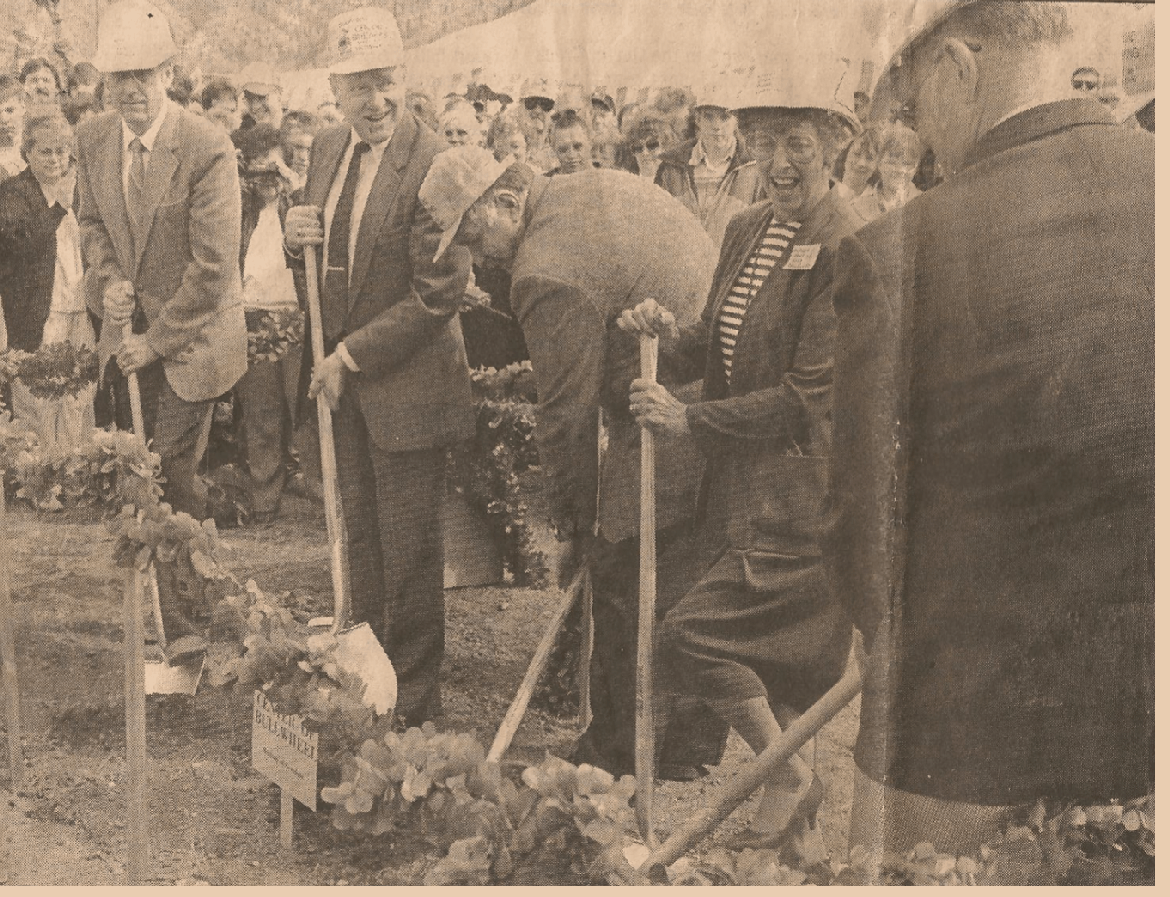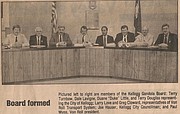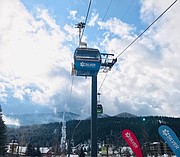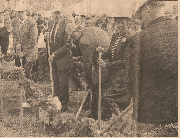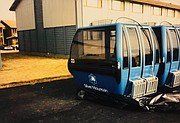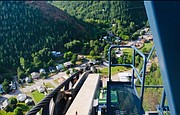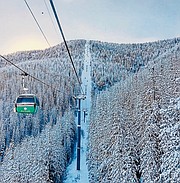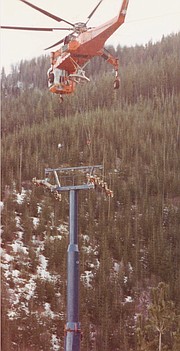Silver Mountain’s gondola celebrates its pearl anniversary
It’s always fun to look back and think about how things were different, but sometimes it is even more interesting to look back and imagine how things would be today if specific decisions were never made.
Thirty years ago this year, the city of Kellogg made a decision that forever altered their trajectory and one that definitely has played a part in the economic viability of Shoshone County’s largest community.
This story is almost as old as the town itself, which due to many of the moving parts affected the decision to build the (then) world’s longest single-stage gondola at Silver Mountain.
We should start with Silver Mountain, the simple ski hill that was known as the Jackass Ski Bowl when it was founded in 1967 by the Fabulous Valley Development Corporation, who sold shares of stock to fund the construction of the new ski area.
Silver Valley residents were given an option to purchase stock through labor or purchase.
Access to the ski hill was limited and required cooperation with the Bunker Hill Mining Company (more on them later), who owned much of the land needed to build the road to the top of the mountain.
The Jackass Ski Bowl was fairly limited during their original days, no where near the 70-plus trails that the mountain boasts today, but to keep the attraction fresh the mountain’s management continued developing more runs and trails for skiers.
That continued development proved costly and in 1973 the Jackass Ski Bowl went bankrupt and was then purchased by the Bunker Hill Mining Company at auction for just $100,100.
Under the new guidance of the Shoshone Recreation Inc., a subsidiary of the Bunker Hill Co., the mountain’s name underwent its first change, from Jackass Ski Bowl to Silverhorn.
Traditionally, skiing had been an activity that was loved by nearly all of the residents of the area, and despite notions of it being an expensive hobby many of the residents in the area were employed at high paying mining jobs or mining related industries.
The Bunker Hill Mine had been in operation since before the turn of the century, and was actually older than Kellogg itself, but in the late ’70s and early ’80s federal regulatory agencies had began to take notice of the pollution and contamination coming from the Bunker Hill’s mining and smelting operations and they were shut down in 1981.
The financial burden of the Silverhorn was too much for the Bunker Hill Co. to endure and the mountain was shut down that same year.
Fortunately, Bunker Hill Limited, a different managing entity formed by Jack Simplot, Duane Hagadone, Harry F. Magnason and Jack Kendrick, bought the ski area and kept it open.
Unfortunately, that was short-lived and in 1983, the operation of the ski area was stopped due to the rising costs of maintaining the Silverhorn.
There was something different about this closure however.
Bunker Hill Limited had reached out to the city of Kellogg prior to closing to see if they would be interested in managing and operating the Silverhorn, citing the city’s need to have some sort of industry that would draw outside dollars to Kellogg.
In 1984, the city of Kellogg entered into a lease arrangement with Bunker Hill Co., giving Kellogg the right to operate the ski area in exchange for the payment of all property taxes levied against the ski area land and improvements.
So this brings us to the mid-1980s, where Kellogg was still searching for its post-mining identity.
From an industry standpoint, the city’s economic backbone rested solely on the growing Dave Smith Motors and then it was mainly outside employment in the surrounding areas.
The Silverhorn had potential to be great, but there was a glaring issue that Kellogg city councilman Wayne Ross had noticed and was looking to address.
Access to the top of the mountain required skiers to drive the Sierra Nevada Road, a 7.2-mile trek on single lane, mountain road.
Navigating the winding road that begins at the top of Wardner, was a serious turnoff for a lot of people, especially those who lacked the confidence for winter driving in less than optimal conditions.
Councilman Ross’s idea… Build a gondola.
And not just build a gondola, but build a gondola that stretched from the middle of town and went up to the top of the ski hill that would include plans for a further expanded ski hill and a summer resort.
The concept of a summer resort in particular made a lot of sense for the city, who wanted to make sure that they were getting the most out of their investment into the Silverhorn.
Ross’s idea led to the forming of the Gondola Board, which was comprised of Duane Little, Terry Douglas, Dale Lavigne, Terry Turnbow, and three representatives from Swiss lift manufacturer Von Roll Tramways.
Deciding on the gondola was an easy decision, but deciding on where it should go was a more trying endeavor.
“Many people wanted the gondola to go all the way up to Kellogg Peak, but there were a lot of reasons to not go up to Kellogg Peak, including the fact that there was no beginner area there for skiing,” Duane Little said.
“We also had initially wanted to put the gondola base near Elizabeth Park because there was an easier route to the lodge location from there, but the board and the city wanted it in Kellogg.”
Little served as co-chairman of the Gondola Board and was instrumental in several major aspects of the development and construction of the gondola.
This group was tasked with figuring out how the massive project would be funded, which would be no easy task as the price tag was in the millions.
At first, the committee was struggling to find a developer to take on the project, and according to notes from Little, they were actually told by one developer that the gondola project wasn’t feasible, but Little had been talking with another company from Europe who had other plans.
“Von Roll was wanting to build something in the U.S.,” Little said. “At that time, they had only built gondolas and chairlifts in Europe. We got told that the project wasn’t feasible, but 18 days later we had a draft contract with Von Roll Tramways.”
In December 1987, Congress approved a $6.4 million grant to assist in the construction of the gondola, the city of Kellogg passed a $2 million bond (84% in favor), and then other funds were secured through in-kind agreements where labor would be traded in lieu of money, even land trades were executed to make sure that all of the boxes were checked.
Washington Water Power (now known as Avista Utilities) did $400,000 worth of work to ensure that there was power to the top of the mountain where crews would be building the lodge.
As mentioned, Von Roll Tramways was looking to build outside Europe and agreed to guarantee the remaining funds needed to construct the gondola.
The Hagadone Hospitality group also was involved in the project as then-president Jerry Jaeger put together the advertising plans for the gondola, as well as installing the new management team for the new and improved destination ski area.
After securing the necessary funding, the plans were laid, and in 1989 ground was broken on the new gondola and the facility upgrades.
The groundbreaking was a spectacle to behold, and was attended by U.S. Senator Jim McClure, Duane Hagadone, and many prominent local figures including local businessman and Gondola Board member Dale Lavigne, who was excited at the future possibilities for an area that had really been depressed in the eight long years since the Bunker Hill had shut down.
“We are on a new horizon now,” Lavigne said following the groundbreaking. “And the only thing that will stop us is our ability to dream a little and make things happen. We have the opportunity to make this one of the finest destination ski areas in the country.”
Now… To build a gondola of this size (longest in the world at its time) and in this location, with this terrain was an undertaking of epic proportions.
At more than 3 miles long, the gondola’s path would require several aerial lift pylons to be installed at differing intervals depending on the location and terrain.
These pylons would be the supports for the 2 1/8-inch thick steel cable that carries the cars up and down the mountain using a motorized bullwheel that keeps the system in a state of continuous motion unless the engine is shut off.
Each gondola cart has a connecting arm with a detachable grip so that the carts can be removed if they need maintenance or replaced.
Through various labor and agreements utilizing the Bureau of Land Management, the swath of forest lands that needed to be cleared was cut and then it was time for the pylons to be placed.
To place the pylons, concrete foundations had to be poured on site before being flown in.
The specific pylons used varied in size due to the differing needs of the terrain and necessary elevation and came in pieces.
Some of the pylons were single pieces, but ranged in size from single piece all the way to three pieces and had to be placed and attached using an Erickson Air Crane Helicopter.
Erickson Air Cranes are truly a marvel of modern technology, especially then when they really made the project a possibility.
Each Air Crane could lift up to 25,000 pounds and place their payload within an inch or two of the desired location using an advanced automatic flight control system to aid in stability.
Construction was also underway at both ends of the gondola, the base in Kellogg and the lodge.
Although it is hard to imagine now, just 15 years ago Silver Mountain was still just the gondola base, the gondola itself, and then the lodge at the top.
This was prior to the construction of the condos and Silver Rapids Waterpark, but the Silver Mountain Base was absolutely a marvel in its design and building itself.
Timberhouse Post and Beam, a specialty timberframing company from Victor, Mont., was brought in to construct the frame work of the base, which included 1,107 timbers and 4,000 pegs to connect them.
The timber used was locally harvested and came from Whiteman Lumber.
Timber framing is an exact science, and if a single timber is off by as little as an 1/8 of an inch, the entire structure would be two inches off the foundation designs.
Work at the Mountain Haus Lodge also went according to plan as contractors had to routinely navigate the Sierra Nevada Road with building materials and supplies, while also braving the usual winter weather.
Changes to the ski hill itself were in the works as the decision was also made to change the original Jackass Chairlift and rename it Chair 4, which was also due to the fact that they added Chairs 1, 2 and 3 to the mountain.
This led to a number of new ski runs for skiers to try their hand at.
Chair 5 was added in a few years, along with the construction of the outdoor amphitheater.
With the new gondola’s construction underway, the city of Kellogg decided that it was time to really begin rebranding itself too.
They settled on a Bavarian theme, in an effort to copy and hopefully replicate the success of Leavenworth, Wash., some 260 miles from Kellogg.
This included adding murals, scalloped trim and other alpine design elements that fell in line with the Germanic concept.
It was also decided that the mountain would be moving on from the name Silverhorn, which was ironic given that the name had been a play on the Matterhorn, arguable the most famous peak in the Alps.
Little still remembers how satifying it was to see the gondola as a finished product, both due to the pride of the work that he and so many others had put into it, but also because there had been so many doubters who had tried to detract from it coming to fruition.
“My favorite part of this project was seeing it completed,” Little said. “A lot of people said, ‘that damn gondola will never be built.’ Even after we passed the bond, a lot of people were against it. I still have never figured out why. Maybe they were afraid of the change, maybe they thought the city shouldn’t have put the money in to it. I don’t know, but I was happy to see it get completed.”
Councilman Ross died in 1986, well before there were ever plans in place for the gondola, but fate made sure that he would be connected as his wife, Joan would take the first official ride on the gondola (following testing), according to Little.
In June 1990, the newly christened Silver Mountain was officially opened for operations and since the grand opening was in the early summer, everyone had an opportunity to see what summertime on Silver Mountain would be like.
Tickets were pre-sold out, a commemorative coin was available and thousands of people were on hand to see the first round of gondola rides.
Concerts, hiking, huckleberry picking, scenic chairlift and gondola rides, as well as mountain biking were all big hits.
Concerts have since been discontinued, but artists like George Thorogood, Weird Al Yankovich, the boy band O-Town and Ted Nugent have been among those who have had shows on top of Silver Mountain.
Over the years, ownership has changed hands a few more times, including as recently as 2016 when Tryg Fortun, manager of Eclectic, LLC purchased it from Jeld-Wen for $5 million (less than the entire cost of the gondola in 1989).
Jeld-Wen had owned the resort since 1996 and had been responsible for the construction of the waterpark and condos.
The gondola was a game changer in the way people viewed Silver Mountain, instead of a trek to Kellogg, followed by another trek to the ski hill, people could get to Kellogg and then enjoy their trip to the top instead of it being a potential stressor.
“Without the gondola, I think Silver Mountain would still be viable for people who love to ski, but I don’t know that it would have nearly the popularity that it has today,” said Gus Colburn, Silver Mountain marketing manager. “Instead of having to drive to the Sierra Nevada, people can get off of I-90, get on the gondola and be skiing, snowboarding, tubing or mountain biking in less than a half hour.”
While skiing will always be the priority, in recent years mountain biking has taken great strides to become equal if not greater in popularity as a Silver Mountain attraction, but a lot of that has had to do with the gondola.
“Before the gondola, we didn’t have any summer operations,” Colburn said. “That’s when we started the hiking and mountain biking. The mountain biking in particular has really blown up, along with the scenic rides and the Ride and Dine in the summertime. It really opened up a lot of possibilities for us.”
Silver Mountain will be celebrating the gondola’s 30th anniversary with a celebration this summer, Colburn believes it will be sometime in mid-July.
Silver Mountain is also gearing up for another full slate of summer events, including the annual Leadman Triathlon, Stix and Stones Motocross, the North American Cup series, as well as Brewfest, the Ride and Dine events, and much more.
Unfortunately, the distinction of being the world’s longest single stage gondola may have been taken, it is still the longest in America.
“I’m pretty sure the one that beat us is just, like, 50 feet longer than ours,” Colburn said with a chuckle.
For more information, visit silvermt.com.




